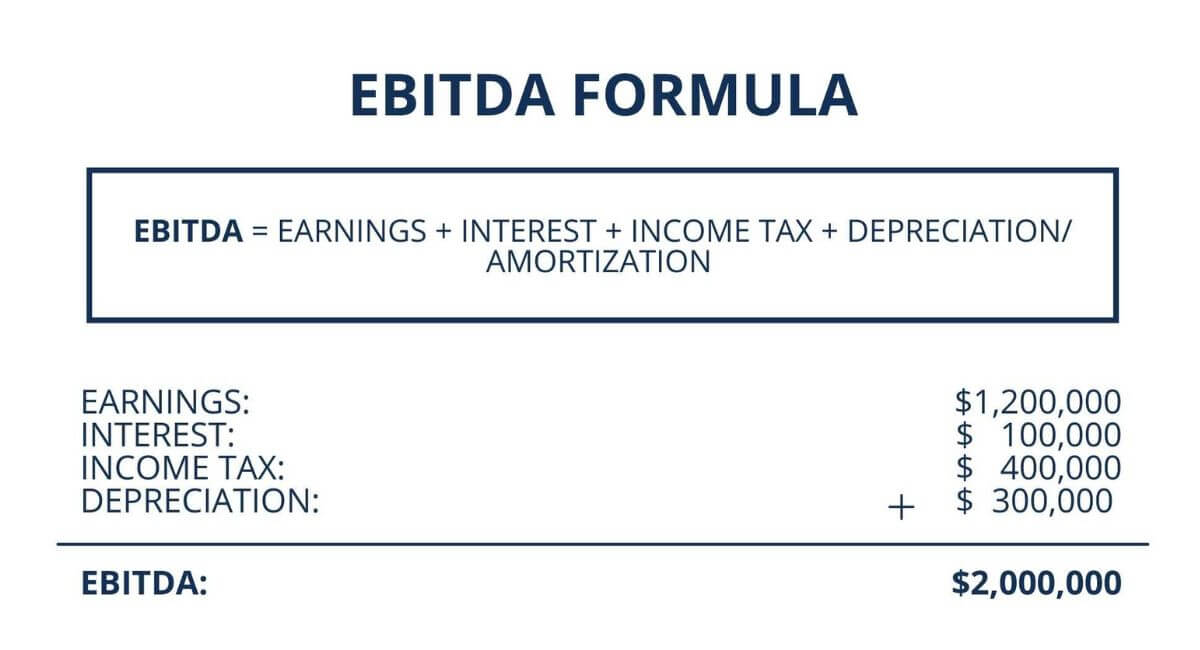What’s the Formula for EBITDA and How to Calculate It
EBITDA isn’t an alien concept – the abbreviation stands for earnings before interest, taxes, depreciation, and amortization.
Put in simple terms, it represents the core earnings of a company. It’s a measure of operational performance and business health. When calculating profitability, EBITDA doesn’t take into account things like depreciation, taxes, and debt financing. Hence, it’s often seen as a loose proxy for cash flow.
It’s possible to calculate EBITDA in two different ways and that’s what we’re about to discuss today. The guide will also provide examples to make the formula clearer and easier to utilize.
What Is EBITDA
In its very essence, EBITDA is a metric that many investors and business owners use to assess the financial well-being of a company that they’re interested in.
The history of EBITDA starts in the 1980s when investors started employing it for the very first time. Originally, the calculation was made to determine whether a company experiencing financial strain would be capable of paying back interest on a leveraged buyout deal.
Today, it’s become a standardized measure of profit.
While a company does not have an obligation to disclose its EBITDA information, generally accepted accounting principles (GAAP) suggest that the calculation can be accomplished by examining the financial statements of a company.
According to supporters of EBITDA as a metric, it delivers a very clear representation of operational performance by stripping away expenses standing in the way of an accurate assessment. On the downside, an EBITDA calculation on its own can sometimes suggest a company has more money at its disposal than it actually does.
How to Calculate EBITDA: The Common Formulas

There are two formulas that can be used to calculate EBITDA. The first one uses operating income while the second one uses net income.
Operating Income EBITDA Calculation
Here’s the first formula:
EBITDA = Operating Income + Depreciation + Amortization
In this formula, the term operating income stands for company profit minus the operating expenses.
Net Income EBITDA Calculation
The formula is:
EBITDA = Net Income + Taxes + Interest Expense + Depreciation + Amortization
All of these figures can be found on an income statement, hence the EBITDA calculation is easy to make even when it’s not presented by the company itself. Here’s a simple overview of each:
- Interest: business expenses that are incurred because of interest rates (like the interest on bank loans or money provided by third-party lenders)
- Taxes: federal and state taxes, as well as local taxes that may be imposed on a particular company
- Depreciation: a reduction in the value of company assets – a non-cash expense that accumulates over time
- Amortization: also a non-cash expense that revolves around the cost of intangible assets
Keep in mind that the two EBITDA formulas can produce different results because of the income specifics. Very often, net income includes items that aren’t accounted for in operating income.
EBITDA Used in Valuation (EV/EBITDA Multiple)
When speaking about EBITDA, we have to mention the EBITDA/EV (enterprise value) multiple.
This financial valuation ratio is used to determine a company’s return on investment (ROI). Once again, it is normalized for differences across companies, which is why the ratio may be preferred over other ROI calculations.
How to Find EBITDA/EV Multiple
The formula for the multiple is as follows:
EBITDA Multiple = Enterprise Value / EBITDA
The enterprise value calculation can be completed using the following formula:
EV = (Market Capitalization + Value of Debt + Minority Interest + Preferred Shares) – Cash and Cash Equivalents
Here’s a simple example of how the multiple works.
We used Target as a well-known brand. Its financial information is publicly available:
- Target’s EBITDA: 7.594 billion US dollars
- Target’s enterprise value: 93.617 billion US Dollars
- EBITDA Multiple = 93.617/7.594 = 12.3x
EBITDA Calculation Examples
To finalize the guide, we’d like to provide actual EBITDA calculation examples. These shed more light on the formula, its usability and limitations.
Before diving into the numbers, we need to mention the fact that EBITDA calculators are readily available online. If you have information about a company’s financial performance, you can easily enter the digits into the online tool to get an accurate calculation.
Example 1
In the first example, we’ll calculate Starbucks’ EBITDA.
The Starbucks Corporation financial statement is publicly available. From it, we extract the numbers required to do the EBITDA calculation:
- Net income: 4,518 million
- Interest: 21.1 million
- Income tax: 1,262 million
- Depreciation and amortization: 1.247 million
- EBITDA = 4518 + 21.1 + 1262 + 1247 = 7,048 million US dollars
Example 2
Apple is another major corporation that has its annual financial reports available to the general public. From the 2018 report, we can easily extract the numbers needed to make the EBITDA calculation:
- Net income: 59,531 million
- Interest: - 2,005 million
- Income tax: 13,372 million
- Depreciation and amortization: 10,903 million
- EBITDA = 59531 – 2005 + 13372 + 10903 = 81,801 million US dollars
Why Use EBITDA?

As a business owner, you may want to use the EBITDA calculation because of all advantages listed above. A few more reasons why it makes sense the assessment of your organization’s financial health include:
- It gets rid of non-operating and non-cash expenses that often complicate calculations and are somewhat arbitrary
- You get a nice alternative to standard metrics like revenue, earnings and net income and it reflects operating profitability specifically
- Through EBITDA, you can easily demonstrate your company’s value to potential investors
- Stripping down certain kinds of expenses simplifies the process of comparing different entities across industries
- EBITDA can be used in tandem with other metrics to deliver comprehensive information on the wellbeing and the profitability potential of a business
Reasons why EBITDA is a Good Metric
There are several reasons why the EBITDA calculation is so widely used:
- A good evaluation of business health: the EBITDA calculation makes it easy to come up with an accurate calculation of business health based on available cash. It’s a simple and stripped down view of profitability that eliminates the subjectivity of making depreciation and amortization calculations. Because they are non-cash expenses, depreciation and amortization can be difficult to calculate accurately. Additionally, these calculations can often be the subject of personal judgment or estimation, which may result in over or under-estimation of financial performance.
- A great tool for small business owners: small business owners and startup entrepreneurs often use EBITDA to understand a company’s value and financial health. It’s one of the most uncomplicated calculations out there and it’s a perfect tool due to the fact it gets rid of arbitrary factors. The performance of the company also becomes very easy to compare against the performance of the competition.
- Looking at the big picture: as already mentioned, EBITDA was originally used to show whether a company is of interest as a leveraged buyout choice. It delivers big picture information and paints an accurate picture of growth potential. Essentially, EBITDA tests out a certain business model to determine its viability and prospects for long-term profitability.
- Easier comparison: when the EBITDA formula is used, comparing the financial health of different companies becomes a breeze. It can also be applied to various capital structures because interest is ignored in the calculation.
- Excellent for assessing potential mergers and acquisitions: in a typical merger and acquisition scenario, debt is not assumed by the buyer. Hence, an entity interested in a certain company wouldn’t have a lot of interest in determining how a company is financed. Available cash flow is going to be a much more important metric.
Disadvantages of Using EBITDA
Now that you know how to get EBITDA and what the benefits of the calculation are, let’s take a look at a few disadvantages:
- An incomplete picture: when certain factors are stripped from the profitability calculation, the end result is an incomplete picture of financial health.
- No consideration for intangibles: a company’s profitability does depend on a number of intangible assets (trademarks, brands, patents) that cannot be accounted for in the EBITDA calculation.
- EBITDA numbers can be manipulated: some companies do inflate their revenues. When taxes, amortization and depreciation are factored out of the equation, just about any enterprise will look attractive and promising.
- Can be used to “mask” poor financial decision-making: because the cost of debt is ignored, the EBITDA calculation can easily conceal poor financial choices and make the situation appear much more positive than it actually is.
- Using EBITDA alone can limit financing choices: based on EBITDA alone, you may be incapable of securing a loan for your business. Entities that provide lending opportunities usually assess a company’s actual financial performance (in which case, the picture may be different from the one that the EBITDA calculation paints.
EBITDA vs. Operating Cash Flow
Because it adds non-cash expenses (depreciation and amortization) back to net income, operating cash flow is a better indicator of how much cash a firm generates. It also incorporates changes in working capital, such as receivables, payables, and inventories, that use or give cash.
Working capital trends are significant in determining how much cash a firm generates. Investors that do not consider working capital changes in their research and instead depend simply on EBITDA may overlook indications, such as challenges with receivables collection, that may affect cash flow.
EBITDA vs. EBT and EBIT
As previously stated, earnings before interest and taxes (EBIT) is a company's net income minus income tax and interest expenditure. EBIT is a metric that is used to assess the profitability of a company's fundamental activities.
The following formula is used to calculate EBIT:
\textit{EBIT} = \text{Net Income} + \text{Interest Expense} + \text{Tax Expense}EBIT=Net Income+Interest Expense+Tax Expense
Because net income includes interest and tax charges, these deductions from net income must be reversed to compute EBIT. EBIT is sometimes confused with operating income since both remove tax and interest charges. EBIT may, however, contain nonoperating income, but operating income does not.
Earnings before tax (EBT) shows the operating profit achieved before taxes, whereas EBIT eliminates both taxes and interest payments. EBT is computed by adding the company's net income to the tax cost.
Investors can use EBT to estimate the efficiency after deducting tax obligations, which are often outside of the company's control. This is mainly relevant in the United States for comparing firms that may be subject to varied state rates of federal tax regulations.
EBT and EBIT include non-cash expenditures such as depreciation and amortization that EBITDA does not.
Final Thoughts on EBITDA & How to Calculate it
EBITDA is a simple profitability metric that can be especially beneficial for small business owners and those making their first steps in the corporate world. Because of the way in which EBITDA is calculated, however, it does pose some limitations.
For the most accurate and comprehensive picture of financial reality, it’s essential to examine EBITDA alongside other metrics. EBITDA solely measures profit in the form of an actual amount. The calculation fails accounting for non-tangible assets and non-cash expenses. While this is often perceived as its biggest strength, it can also become the metric’s weakness.
Thus, EBITDA can be beneficial when comparing a company’s performance to that of others or when trying to eliminate industry specifics. It can also be useful in talks with investors. EBITDA on its own, however, may paint a picture that isn’t necessarily reflective of an entity’s fiscal health and long-term profitability potential.
Kristen Larson is a payroll specialist with over 10 years of experience in the field. She received her Bachelor's degree in Business Administration from the University of Minnesota. Kristen has dedicated her career to helping organizations effectively manage their payroll processes with Real Check Stubs.

